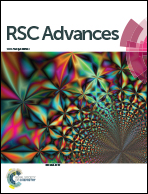Destabilization of lithium hydride and the thermodynamic assessment of the Li–Al–H system for solar thermal energy storage†
Abstract
Lithium hydride destabilised with aluminium, LiH–Al (1 : 1 mole ratio) was systematically studied and its suitability as a thermal energy storage system in Concentrating Solar Power (CSP) applications was assessed. Pressure composition isotherms (PCI) measured between 506 °C and 652 °C were conducted to investigate the thermodynamics of H2 release. Above the peritectic temperature (596 °C) of LiAl, PCI measurements were not consistently reproducible, possibly due to the presence of a molten phase. However, below 596 °C, the hydrogen desorption enthalpy and entropy of LiH–Al was ΔHdes = 96.8 kJ (mol H2)−1 and ΔSdes = 114.3 J (K mol H2)−1, respectively LiH(s) at 956 °C, ΔHdes = 133.0 kJ (mol H2)−1 and ΔSdes = 110.0 J (K mol H2)−1. Compared to pure LiH, the Li–Al–H system has a reduced operating temperature (1 bar H2 pressure at T ∼ 574 °C) that, combined with favourable attributes such as high reversibility, good kinetics and negligible hysteresis, makes the Li–Al–H system a potential candidate for solar thermal energy storage applications. Compared to pure LiH, the addition of Al can reduce the cost of the raw materials by up to 44%. This cost reduction is insufficient for next generation CSP but highlights the potential to improve the properties and cost of high temperature hydrides via destabilisation.



 Please wait while we load your content...
Please wait while we load your content...